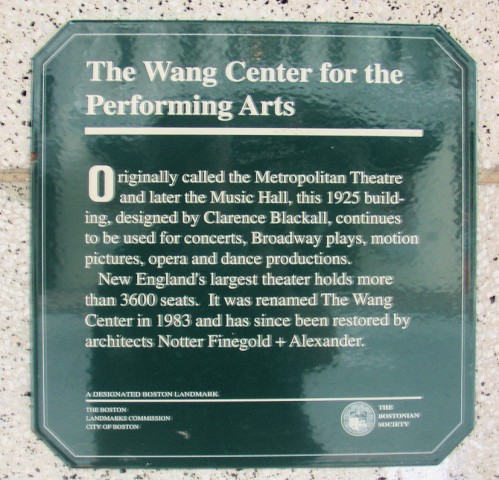This theater has gone through several name changes, first called the Metropolitan Theatre, or "The Met," and then in 1962 it was renamed The Music Hall, becoming home to the newly formed Boston Ballet. In 1980 it became the Metropolitan Center, as a non-profit theater corporation. Just a few years later in 1983 it was named the Wang Theater, or Wang Center for the Performing Arts, in honor of patron Dr. An Wang. In 1996, the Wang became part of the Citi Performing Arts Center, along with the nearby Shubert Theatre, but retains its name as the Wang Theatre.
A nearly ten million restoration project has returned this magnificent theater to the splendor of its original design. Throughout its history it has hosted so many outstanding productions of the stage, opera, music and film. It has one of the largest screens in New England where classic films are shown, and new releases of the past were screened.
It is a designated Boston Landmark and is a contributing building to the Piano Row District, list in the National Register of Historic Places.

The Wang Center for the Performing Arts
Originally called the Metropolitan Theatre and later the Music Hall, this 1925 building designed by Clarence Blackall, continues to be used for concerts, Broadway plays, motion pictures, opera and dance productions.
New England's largest theater holds more than 3600 seats. It was renamed The Wang Center in 1983 and has since been restored by architects Notter Finegold & Alexander.
A Designated Boston Landmark
The Boston
Landmarks Commission
City of Boston
The
Bostonian
Society
From the
Midtown Cultural District Historic Buildings
Music Hall/Metropolitan Theatre
Architect: Chief Designers: Blackall, Clapp and Kenneth Franzheim, G. Nelson Meser
Builder: Olympia Construction Co.
Irregularly-shaped Renaissance Revival "palazzo skyscraper" with symetrical, 11-bay Tremont facade. Two-story colonnade of engaged fluted Greek Ionic columns at level 2-3. Shaft of building organized by rising piers, recessed spandrals and paired metal window units, with ornament concentrated at level 4 and 5. Building terminated by two-story colonnade of engaged Corinthian pilasters at level 12 and 13, plus denti cornice and roof cresting of palmettes and theatre masks.
The Music Hall/Metropolitan is highly significant as the largest theatre in Boston history and one of the largest in the country, as the best example of the sumptuous "movie palace" of the roaring twenties and as the last of Clarence Blackall's 14 Boston theatres.
The theatre reputedly cost 8.5m, seats 4200-4400, and is housed in a large office building, first to be constructed in Boston under a new height limit of 14 stories. Architect Clarence Blackall (1857-1942), one of the leading U.S. theatre architects and designer of the Colonial, Wilbur, Modern and Pilgrim/Olympia. The interior, modeled after Garnier's Paris Opera and decorated in the Louis XIV style, was appropriately advertised as "the public castle" with "a thousand and one wonders" including the grand lobby with four tiers of prominades, spacious lounges, marble doorways, rose jasper pillers, tow 1800-lb. gold plated chandeliers, bronze details by the Gorham Company, and $10,000 in gems decorating the central mural painting by Edmund Philo Kellog.
The entertainment was equally extravagant. The Met offered a combination of films and stage show, which might feature its resident ballet corps, 100-voice chorus, 55-piece orchestra and two console organ, all for 35 cents or 75 cents on weekend evenings. Resident producer John Murray Anderson arranged his own stage shows, headlined over the years with stars such as Rudy Vallee, Al Jolson, Burns and Allen, Jack Benny and Bob Hope. A seating board and cadre of 40 well-mannered, costumed ushers made sure that no seat remained empty long. Waiting patrons could arrange for bridge parties, lounge in comfortable chairs with the latest magazines, prominade to the music of two lobby orchestras, play ping pong, or visit the chic art deco restaurant which opened in 1932.
Since the destruction of the Boston Opera House in 1958, the Metropolitan has been used for performances by the Royal Ballet, Metropolitan Opera Company, Bolshoi, Kirov and Stuttgart Opera. Has been "Music Hall" leased by Sach Theatres since 1962.